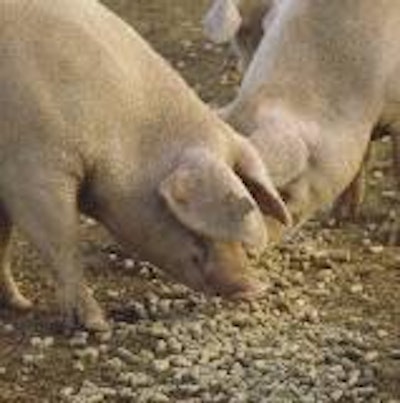
Sow productivity can benefit from an age-specific approach to the nutrition of the females in a pig breeding herd. The common practice of having only 2 diets one for gestation and the other for lactation to cover the whole herd is well overdue for change. There is today a firm rationale for organising the sows into 2 sub-populations for age-based feeding.
In addition, a separate section of housing to hold sows between weaning and mating would allow them to receive dedicated feeding in the form of 4 feeds per day to promote litter size. This could evolve into a feed strategy from weaning until 30 days after mating, if it can be demonstrated that the nutrition applied in early pregnancy improves embryo viability by modulating the immune system.
Treating young and older sows separately from a nutritional perspective recognises their different requirements for both the total quantity and the type of nutrients fed per day. Those differences can be understood by comparing the young, immature sow in the first or second parity with her fully mature counterparts that have already had 5 litters or more. Especially the first-parity female may lose an excessive amount of body protein during her lactation if she produces enough milk to nurse a large litter. The greater this loss, the more her subsequent weaning-to-oestrus interval will lengthen. Often it is extended so much that the animal risks being culled prematurely for a failure to re-breed.
A direct relationship also exists between the extent of the loss and the relative sizes of her first and second litters. Where the protein loss is only small less than 2 kilograms, for example the litter size can increase by one piglet from the first to the second farrowing. However, doubling the loss to 4kg would be enough to reduce the second-litter size by 0.75 pigs.
At the other extreme, mature sows typically peak for litter size at the third farrowing and then maintain this level until about Parity 6 before undergoing a progressive decline. But the decrease starts too early in life from the perspective of normal reproductive processes. It may be due more to nutrition and specifically to the supply of micro-nutrients as the sow ages.
The feeding strategy for most sows in pregnancy holds feed intake about constant across all parities to limit growth. Although it will meet their protein and energy requirements, this feed procedure probably does not work for vitamins and trace minerals. The fact that the sow gains weight progressively with advancing age means that, at each parity, she receives a smaller quantity of those micro-nutrients per kilogram of bodyweight. Yet the amount she needs actually increases as she becomes heavier, to support the additional tissue metabolism associated with extra tissue mass.
Unfortunately, this situation of increasing demand and declining supply is repeated at each successive pregnancy. It also occurs in lactation, although to a lesser extent. Therefore the older, heavier sow is placed at increasing nutritional risk, both for her reproduction and for her immunological status.
The proposition has been tested at 2 Hanor farms where sows having 3 or more litters are segregated from younger females. Those acting as controls received the usual vitamin-mineral supplementation of 0.15% of the diet. Test sows were fed increased amounts so that the same micro-nutrient supply per kilogram of bodyweight would apply to a Parity-7 sow as to a Parity-3 animal. Across the period from Litter 4 to Litter 10, equalising the micro-nutrients improved the weaning average by 0.6 pigs per litter or 1.44 pigs per sow/year.
The herd average for sow lifetime production will increase where gilts and first-litter sows are managed nutritionally as one sub-population and older sows are given an adjusted level of nutrients to match their greater seniority. This has been demonstrated at Hanor, where we have also seen sow viability maintained with no extra feed cost per pig weaned. Some of the opportunities for improving performance by age-related feeding are itemised in Table 1.
An essential aim of the division between females from puberty to their second conception and those in Parity 3 onwards is to achieve a large first litter and then to ensure that the second litter size is not compromised. The need for specialised young-sow nutrition probably ends when the animal has reached Day 30 of her second pregnancy. Including Parity-3 and Parity-4 sows in the older category is a practical way of reducing diet costs for gestation and lactation.
The expected outcome in this senior sub-population is to avoid the premature decline in pigs born and weaned. According to our calculations, it can add up to 3.3 pigs to the average output per sow lifetime. The dedicated feeding, such as by using vitamin E to improve the immune response, tries to copy a concept of health aging that is already applied to domestic dogs and cats. Mature sows can also utilise cheaper ingredients in the form of co-products in the feed. In addition, as we will see in the next report, separating sows by age opens the way to a more targeted approach to mineral nutrition in the breeding herd.



.jpg?auto=format%2Ccompress&fit=crop&h=167&q=70&w=250)













